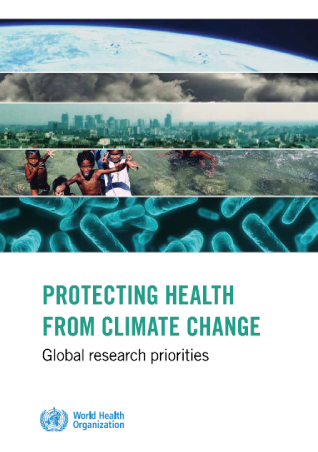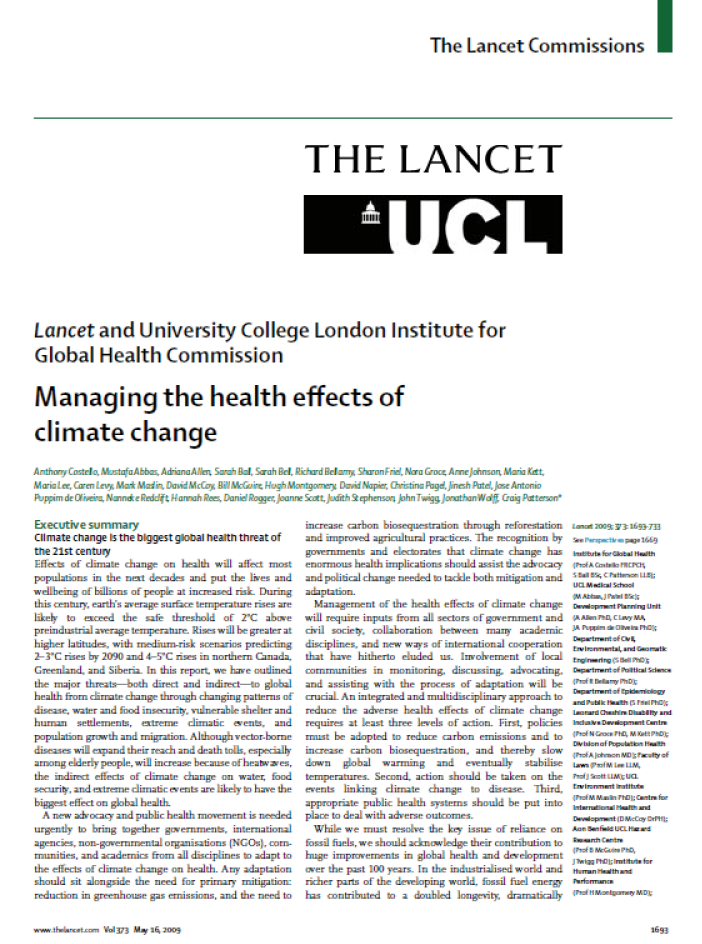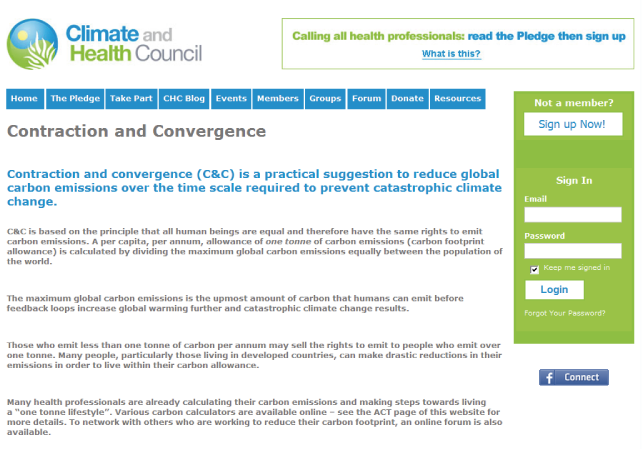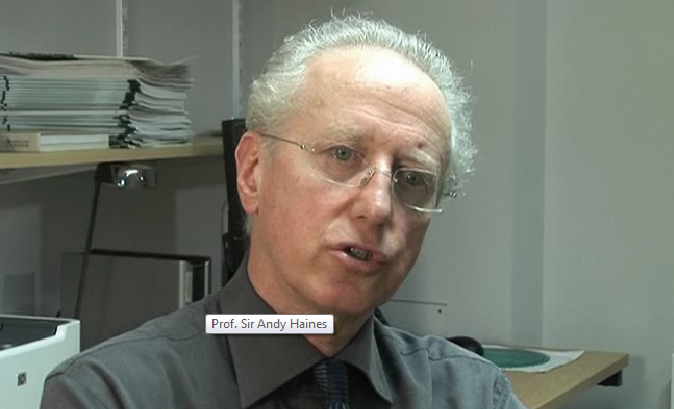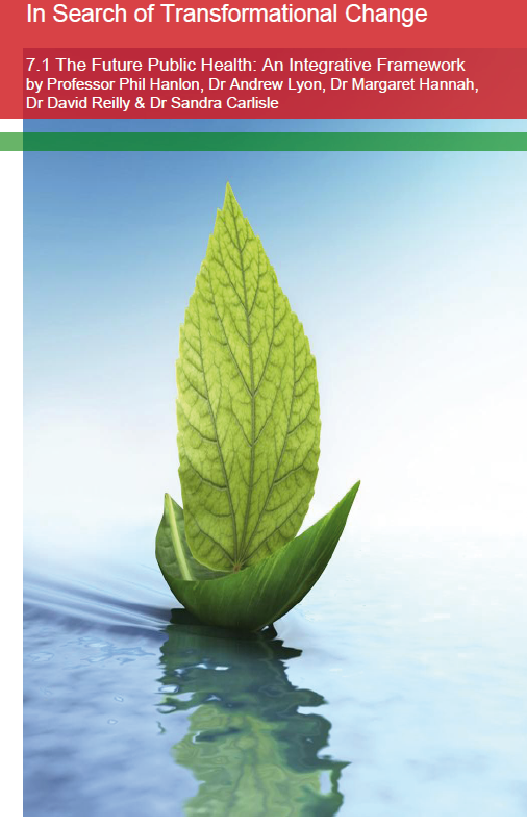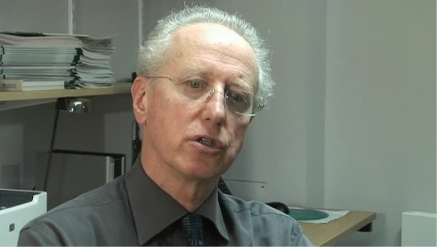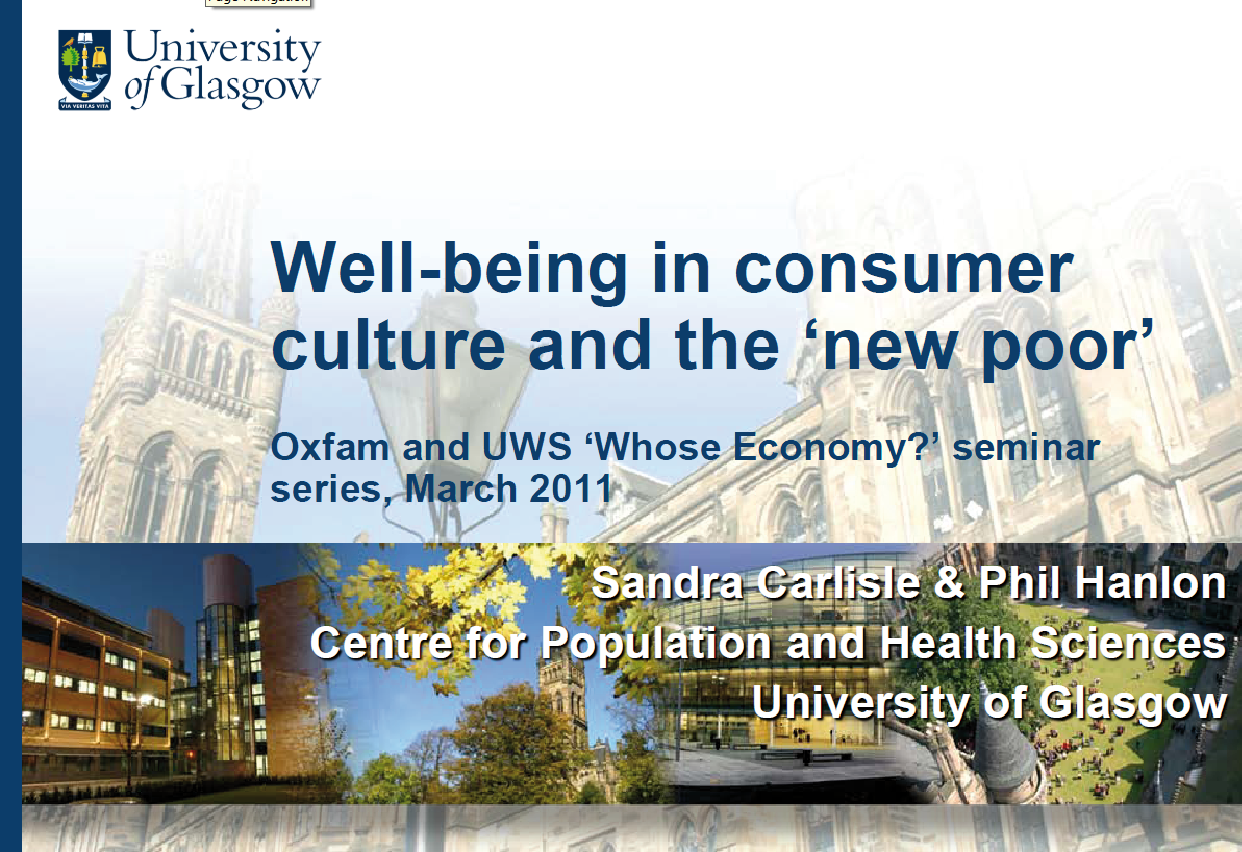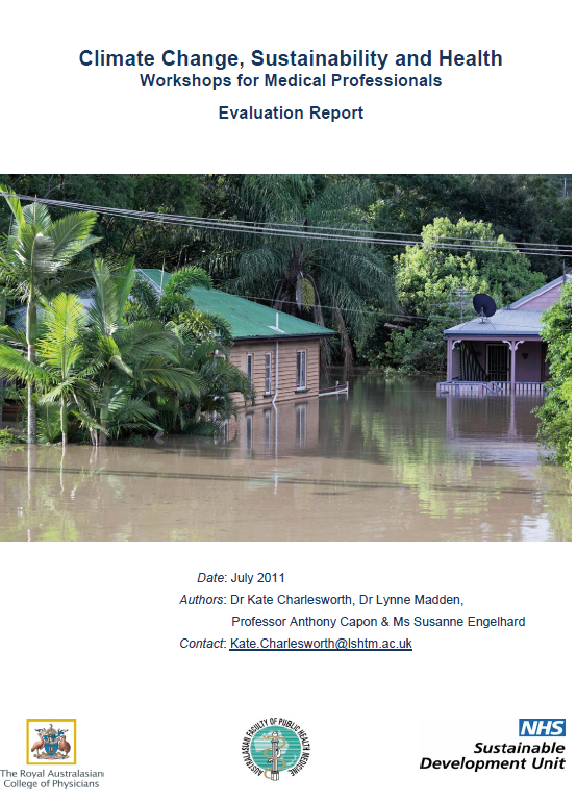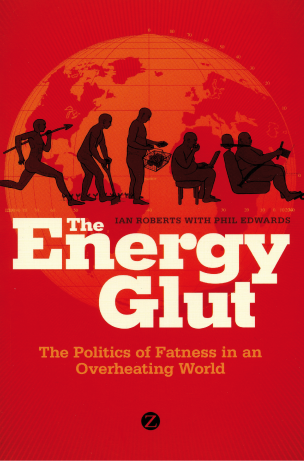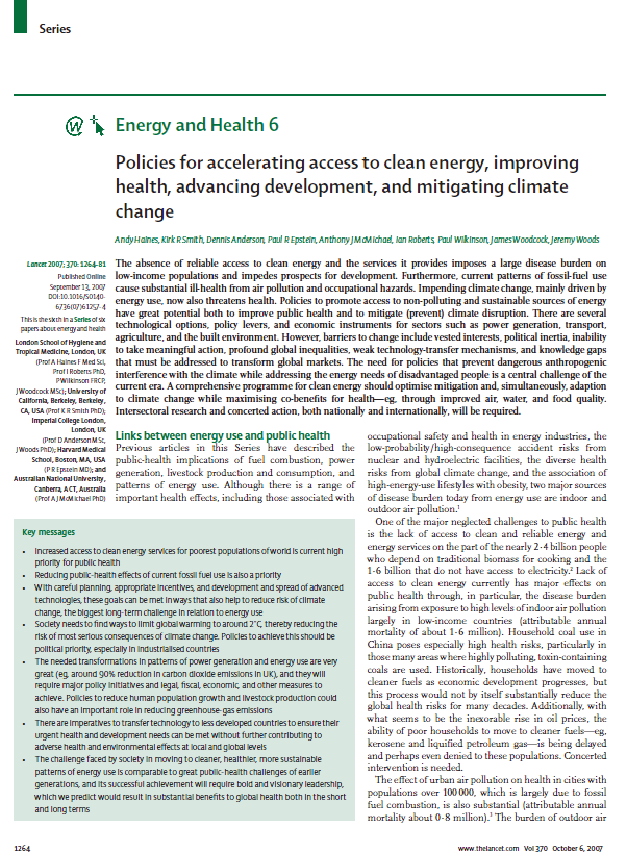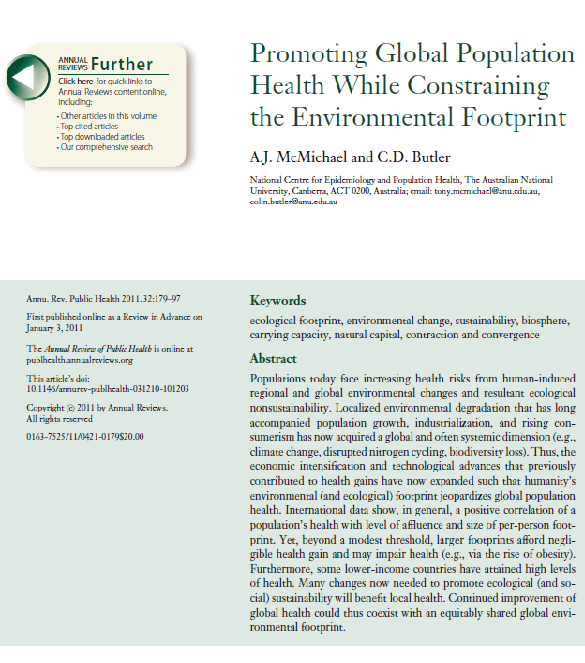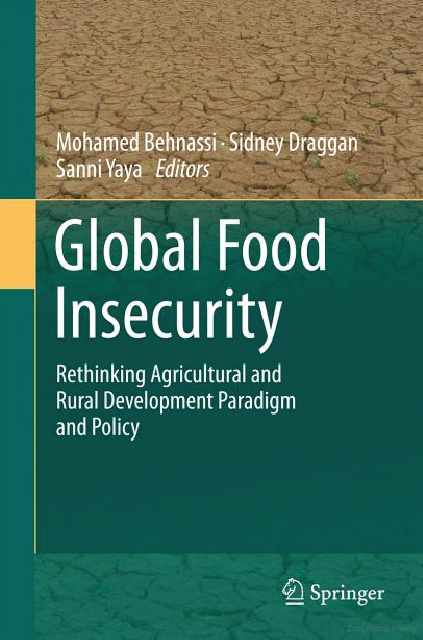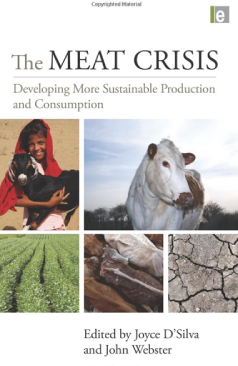Phil Hanlon talks very much about what’s needed not just as a fifth wave but as a new era, not just for public health but for society. The challenges of climate change and peak oil threaten the whole of modernity and could therefore knock back so many of the public health successes that have been a product of the modern age. They argue that we need new economic models that don’t depend on permanent growth and resource depletion, and that for global justice we need these to adopt models of resource use based on contraction and convergence we can’t achieve equity by levelling the poor up to the lifestyles of rich western nations, because that’s not sustainable, so we need to reduce our resource use in order that the whole world can live within its total resource envelope.
At an individual level the suggestion is that if we’re integrating these dimensions of life effectively we need a much more holistic approach, one that recognises the importance of subjective factors to a much greater extent than at present. One of the contributors to the group is David Reilly from the centre for integrative care at the Glasgow Homeopathic Hospital a doctor who became increasingly frustrated with modern medicine, moved towards alternative approaches, and now is even moving to some extent away from these towards what he describes as mobilising people’s inner resources for self healing.
Education and advocacy
The UK Climate Change Act stipulated that the UK is legally bound to reduce emissions from 1990 levels, by 34% by 2020 and by 80% by 2050. Figure 1 illustrates these targets for the English NHS. This huge challenge will require the growth of emissions to be not just moderated but reversed, with a reduction in absolute emissions. This will only be achieved with urgent radical change. Be a sustainability advocate and lead by example. Sign up to the Good Corporate Citizen Assessment model. Good corporate citizenship is using corporate power and resources in a way that benefits the social, economic and physical environment. Take a global health perspective; canvas for personal carbon entitlements within a fair shares global framework such as Contraction and Convergence (Global Commons Institute). Help to stabilize population growth by promoting literacy and access to birth control through Marie Stopes or the International Planned Parenthood Federation. Put sustainability on the agenda, in the practice or on committees. Doctors have a strong voice. Increase your influence and that of all health professionals by joining the Climate and Health Council.
Dr Sally A. Aston - Innovait
A number of proposals have been made for reducing global warming emissions. These range from technological innovations to mechanisms aimed at capping and rationing carbon emissions. One framework for reducing emissions has been labelled contraction and convergence. This relies on the establishment of a time-bound target for reducing global emissions (contraction). Carbon emission quotas would then be allocated equally to all the Earths citizens. However, people would be allowed to trade their quotas, with the likely result that financial resources would flow from the rich to the poor. Over time, it is predicted that disparities in global warming emissions between different population groups would reduce (convergence).
Although there are logistical barriers to the practical implementation of contraction and convergence, it describes a mechanism and approach for reducing global warming emissions which will help tackle poverty and reduce socio-economic inequalities at the same time.
Dr. Mahmood Bhutta, Specialist Registrar, Oxford Deanery, UK.
Ms Belinda Calaguas, Head of Policy, WaterAid, London, UK.
Mr Martin Carroll, International Department, British Medical Association.
Mr. Brandon Cheevers, Policy Associate, WaterAid, London, UK.
Dr. Mickey Chopra, Director, Health Systems Research Unit, Medical Research Council, South Africa.
Dr. Corinna Hawkes, Research Fellow, International Food Policy Research Institute, Washington DC, USA.
Ms Charlotte May, Deputy Head, International Department, British Medical Association
Dr. David McCoy, Department of Epidemiology and Public Health, University College London
Mr. George Roycroft, Senior Policy Executive, Science and Education Department, British Medical Association
Mr. Mike Rowson, Centre for International Health and Development, University College London, UK and freelance consultant
Editors
Mike Rowson, David McCoy and Martin Carroll
Funders
The BMA would like to acknowledge the generous financial support provided by the Department for International Development.
Improving health for the worlds poor: what can health professionals do?
British Medical Association [BMA] International Department
Useful information on Contraction & Convergence at GCI
British Holistic Medical Association
Contraction and convergence conceived by the Global Commons Institute (GCI) in the early 1990s consists of reducing overall emissions of GHGs to a safe level, Contraction, where the global emissions are reduced because every country brings emissions per capita to a level which is equal for all countries, Convergence. For more information on Contraction and Convergence please see
British Medical Association [BMA] 2008
How can the impact of climate change be reduced?
"The few studies that are now beginning to assess the health consequences of decisions aiming to mitigate or adapt to climate change use very different analytical methods and assumptions, even for very similar challenges. There is a need to develop more generic guidance on conceptual frameworks and methods in order to improve comparability, and assist decision-makers to achieve the greatest health co-benefits, and avoid harm. This should cover the full range of potential decisions, from the macro level for example global contraction and convergence in carbon dioxide (CO2) emissions; carbon pricing policy and incentives), to more local and sector specific decisions (e.g. city-level policies to promote public transport, or to protect a natural watershed)."
Protecting Health from Climate Change
Global research priorities
World Health Organisation 2009
"Carbon emissions must be reduced to avoid the worst outcome of the climate change. Developing economies need rapid economic development so that no country, community or individual is too poor to adapt to climate change. The principle of 'contraction and convergence', conceived by the Global Commons Institute, UK, considers the need to pursue both these actions, reducing global carbon emissions and ensuring economic development of underdeveloped countries simultaneously."
WHO South East Asia
Climate change is a fundamental threat to human health
Ensuring synergies
The Commission on Social Determinants of Healths call to bring the two agendas of health equity and climate change together2 requires specific attention. The potential tensions between reducing emissions and creating equitable policies require strategies that keep both goals at the forefront to identify and exploit synergies and co-benefits. Essential conditions for achieving health equity and climate goals can be identified. First, strategies must adhere to key principles, including the fair sharing of burdens embodied in the United Nations Framework Convention on Climate Changes language of common but differentiated responsibilities and the World Health Organization constitutions declaration that all people have a right to the highest attainable standard of health. Principles must also include a commitment to intersectoral action to achieve health equity and climate change in all policies. This provides a further driver for the differential approach to mitigation whereby developed countries contract their emissions while developing countries converge theirs to allow the development that is fundamental for health equity. Second, specific policies need to be carefully designed and assessed. Integrated assessment methods that consider the range of effects on health and health equity can maximize synergies and optimize trade-offs between competing priorities. At the design stage, implementing safeguards and flanking measures, such as recycling revenue from carbon pricing measures, towards health outcomes for disadvantaged groups can help avoid or reduce inequitable effects. Third, further research and continued monitoring and evaluation of policies are required. Interactions between climate policy and health equity are particularly complex and uncertain. Improving health equity is identified as a broad goal of the currently proposed climate change research agenda.9 However, few relevant or specific studies exist. As with all policy, implementation will be necessary without full knowledge of effects and unintended consequences. Success stories and chastening experiences must be shared rapidly and widely to help decision-makers move towards socially beneficial policies. The simultaneous pursuit of climate stabilization and health equity is a political as well as a technical challenge, questioning current economic models in terms of the allocation of resources in society and calling for careful policy design to achieve fairer outcomes. Anyone attempting to improve health equity alongside addressing climate change will need to be as smart as they are well-intentioned.
Natural and unnatural synergies: climate change policy and health equity
Sarah Catherine Walpole, Kumanan Rasanathan & Diarmid Campbell-Lendrum
"Luxury emissions are different from survival emissions, which emphasises the need for a strategy of contraction and convergence, whereby rich countries rapidly reduce emissions and poor countries can increase emissions to achieve health and development gain, both having the same sustainable emissions per person.
Contraction and convergence
Climate change requires two possibly conflicting actions. Carbon emissions must be reduced to avoid the worst outcome of climate change. Poor countries need rapid economic development so that no country, community, or individual is too poor to adapt to climate change. The concept of contraction and convergence, developed by the Global Commons Institute, considers the need to pursue both these actions simultaneously. Contraction and convergence reduce overall carbon emissions to a sustainable level but do so according to an equal share of emissions per person globally. Industrialised countries would dramatically reduce their emissions whilst developing countries would increase theirs to allow for, and stimulate, development and poverty reduction."
Lancet and University College London Institute for Global Health Commission
Managing the Health Effects of Climate Change - Anthony Costello, Mustafa Abbas, Adriana Allen, Sarah Ball, Sarah Bell, Richard Bellamy, Sharon Friel, Nora Groce, Anne Johnson, Maria Kett, Maria Lee, Caren Levy, Mark Maslin, David McCoy, Bill McGuire, Hugh Montgomery, David Napier, Christina Pagel, Jinesh Patel, Jose Antonio Puppim de Oliveira, Nanneke Redclift, Hannah Rees, Daniel Rogger, Joanne Scott, Judith Stephenson, John Twigg, Jonathan Wolff, Craig Patterson
Contraction and Convergence [C&C] is a practical suggestion to reduce global carbon emissions over thetime scale required to prevent catastrophic climate change.
Climate and Health Council
An extensive network of Doctors and Health Professionals
Contraction and convergence
Contraction and convergence has been proposed as the most practical and equitable strategy for reducing CO2 emissions and tackling climate change. This approach has also been proposed by the Global Common Institute and would require the establishment of a global carbon budget with allocation of entitlement of carbon to each region, country or individual18 and major changes in all sections of the economy including: electricity production, transport, housing, agriculture, industry and commerce outlines the injury control benefits that would result from carbon rationing.
Health, Climate Change and Sustainability: A systematic Review and Thematic Analysis of the Literature
A. Nichols 1, V. Maynard 2, B. Goodman 3 and J. Richardson 4
1 Faculty of Health and Social Work, University of Plymouth, 3 Portland Villas, Drake Circus, Plymouth, Devon PL4 8AA, U.K.
2 School of Health Professions, University of Plymouth, 19 Portland Villas, Drake Circus, Plymouth, Devon PL4 8AA, U.K.
3 School of Nursing and Community Studies, University of Plymouth, FHSW L4, Knowledge Spa, RCHT Treliske, Truro, Cornwall TR1 3HD, U.K.
4 Professor of Health Services Research, Faculty of Health and Social Work, University of Plymouth, 19 Portland Villas, Drake Circus, Plymouth, Devon PL4 8AA, U.K.
Environmental Health Insights
Editorial Board MembersCaleb Adegbenro, PhD PhD FRSH
Community Health, College of Sciences, Obafemi Awolowo University, Ile-Ife, Osun, NigeriaAlice L. Anderson, PhD
Professor of Environmental Health Sciences and Safety Program, ECU College of Health and Human Performance, East Carolina University, Greenville, North Carolina, USAStephen D. Arnold, PhD
Professor, Department of Health Science, New Mexico State University, Las Cruces, New Mexico, USA
Akshaya Neil Arya, MD CCFP FCFP
Adjunct Professor Environment and Resource Studies Adjunct Professor, Health Studies and Gerontology, University of Waterloo; Assistant Clinical Professor,Family Medicine McMaster University; Adjunct Professor, Family Medicine, University of Western Ontario, Waterloo, Ontario, Canada
Gerald Mark Barron, MPH
Associate Professor, Department of Health Policy and Management, Center for Public Health Practice, Graduate School of Public Health, University of Pittsburgh, Pittsburgh, Pennsylvania, USA
Joe E. Beck
Professor, Department of Environmental Health, Eastern Kentucky University, Richmond, Kentucky, USA
Lalita Anne Bharadwaj, PhD
Assistant Professor, Toxicology, College of Nursing, University of Saskatchewan, Saskatoon, Saskatchewan, Canada
Cheikh Saad Boye, PhD
Professor; Dean of the Faculty of Medicine; Director of the Post graduate College of Health Sciences and Environment, Department of Microbiology, University Cheikh Anta Diop (UCAD), Dakar, Senegal
Lars Carlsen, DSc
Professor, Awareness Centre, Roskilde, Denmark
William S. Carter, PhD CIH CET
Professor of Environmental Safety and Health Management, Environmental Safety and Health Management, College of Science, The University of Findlay, Findlay, Ohio, USA
Enrique Cifuentes, MD PhD
Professor and Researcher, Environmental Health, National Institute of Public Health, Cuernavaca, Morelos, MexicoAidan A. Cronin, PhD
Associate Research Fellow, Robens Centre for Public & Environmental Health, University of Surrey, Guildford, Surrey, UK
Malcolm P. Cutchin, PhD
Professor, Occupational Science and Occupational Therapy, Division of Occupational Science, Department of Allied Health Sciences, School of Medicine, University of North Carolina, Chapel Hill, North Carolina, USABrenda L. Elledge, DrPH
Assistant Professor, Department of Occupational and Environmental Health; Director, Southwest Center for Public Health Preparedness, College of Public Health, University of Oklahoma Health Sciences Center, Oklahoma City, Oklahoma, USAOana Violeta Enick, MET
Environmental Management Branch, British Columbia Ministry of Environment, Surrey, British Columbia, Canada
Daniel Mark Harper, MPH REHS DHSP DAAS
Assistant Professor, Department of Environmental Health Science, College of Health Science, Eastern Kentucky University, Richmond, Kentucky, USA
Janice Harper, PhD
Assistant Professor, Department of Anthropology, University of Tennessee, USACarolyn Hester Harvey, PhD CIH CHMMÂ
Associate Professor & Coordinator of MPH-EHS Program, Department of Environmental Health Science, College of Health Science, Eastern Kentucky University, Richmond, Kentucky, USAPeter Anthony Harvey, PGCE MSc PhD
Associate, Water, Engineering and Development Centre, Loughborough University, Loughborough, UK
Sharron LaFollette, PhDÂ
Associate Professor & Chair, Department of Public Health, University of Illinois at Springfield, Springfield, Illinois, USAL�Šo Heller, PhD
Associate Professor, Department of Sanitary and Environmental Engineering, Federal University of Minas Gerais, Belo Horizonte, BrazilGuy Hutton, PhD
Consultant, Switzerland
Md. Jakariya, PhDÂ
Faculty Member, Department of Environmental Sciences, Jahangirnagar University, Savar, Shaka, Bangaladesh
Blanca Jimenez-Cisneros, PhD
Professor, Environmental Engneering, Institute of Engineering, Universidad Nacional Autonoma de M�Šxico (National Autonomous University of Mexico), Mexico City, MexicoGuang Jin, DSc PEÂ
Associate Professor of Environmental Health, Department of Health Sciences, Illinois State University, Normal, Illinois, USANadia Juzych, DSc MS
Senior Research Scientist, Michigan Public Health Institute, Okemos, Michigan, USARichard A. Kreutzer, MDÂ
Chief, Division of Environmental and Occupational Disease Control, California Department of Public Health, Sacramento and Richmond, Calfornia, USAEphraim Massawe, PhD
Professor of Industrial Hygiene, Occupational and Environmental Health, Southeastern Louisiana University, LA, USA
Judith Mazique, JD MPH
Program Director of Environmental Health; Assistant Professor; President of the Association of Environmental Health of Academic Programs, Health Sciences Department, Texas Southern University, Houston, Texas, USA
Jane A. McElroy
Assistant Professor, Family and Community Medicine, School of Medicine, University of Missouri, Columbia, Missouri, USAAnthony J. McMichael, PhD
Professor, National Centre for Epidemiology & Population Health, College of Medicine and Health Sciences, The Australian National University, Canberra, ACT, AustraliaMichael N. Moore, PhD
Professor and Science Co-ordinator, UK Joint Environment & Human Health Programme, Plymouth Marine Laboratory, Plymouth, Devon, UK
Michele Morrone, PhD RS
Associate Professor, Environmental Health Science, Ohio University, Athens, Ohio, USA
Ademola M. Omishakin, MPH PhD MBA
Professor and Coordinator, Environmental Health Program, Department of Natural Science and Environmental Health, Mississippi Valley State University, Itta Bena, Mississippi, USA
Sheila Davidson Pressley, MS REHS
Assistant Professor, Department Environmental Health Science, College of Health Sciences, Eastern Kentucky University, Richmond, Kentucky, USA
Pamela Ransom
Assistant Professor, MPA Program, School of Business, Public Administration and Information Sciences, Long Island University, Brooklyn Campus, New York City, New York, USA
David B. Resnik, JD PhD
Bioethicist, National Institute of Environmental Health Sciences, National Institutes of Health, Research Triangle Park, North Carolina, USABruce Rothschild, MD
Professor of Medicine, Northeastern Ohio Universities College of Medicine; Adjunct Professor of Biomedical Engineering, University of Akron; Research Associate, Carnegie Museum of Natural History, Pittsburgh; Research Associate, Museum of Natural History, University of Kansas, Ohio, USA
May Linda Samuel, MPH DD PhD ThD
Associate Professor of Biology and Coordinator of Environmental Health Sciences Technology and Public Health, Division of Mathematics and Natural Sciences, Allen University, Columbia, South Carolina, USA
Cheng B. Saw, PhD
Professor and Director of Medical Physics, Division of Radiation Oncology, Penn State Hershey Cancer Institute, Hershey, Pennslyvania, USA
Bhanwar Lal Sharda, MDÂ
Professor, Department of Pediatrics, RNT Medical College, Krishna, Udaipur, Rajasthan, IndiaLawrence K Silbart, PhD
Professor and Department Head, Allied Health Sciences, Unversity of Connecticut, Storrs, CT, USAGary S. Silverman, DEnv
Professor, Director of the Environmental Health Program; Interim Director of the Environmental Studies Program, Bowling Green State University, Bowling Green, Ohio, USA
Dale Jay Stephenson, PhD CIH
Associate Professor and Director, Environmental and Occupational Health, Community and Environmental Health, College of Health Sciences, Boise State University, Boise, Idaho, USALyndall Margaret Strazdins, PhDÂ
National Centre for Epidemiology and Population Health, ANU College of Medicine and Health Sciences, The Australian National University, Canberra, Australian Capital Territory, AustraliaWilliam A. Suk, PhD MPH
Acting Deputy Director, National Institute of Environmental Health Sciences, and National Toxicology Program, National Institutes of Health, US Department of Health and Human Services, Research Triangle Park, North Carolina, USAJohn Sullivan, MA
Co-Director, Public Forum & Toxics Assistance Division, Division of Environmental Toxicology, Department of Preventive Medicine & Community Health; Community Outreach & Education Core, Sealy Center for Environmental Health and Medicine, National Institute of Environmental Health Sciences Center, University of Texas Medical Branch, Galveston, Texas, USAMansoureh Tajik, PhD
Researcher, Department of Community Health and Sustainability, University of Massachusetts at Lowell, Lowell, Massachusetts, USA
Thomas Daniel Tenkate, DrPHÂ
Senior Lecturer and Postgraduate Course Coordinator, School of Public Health, Faculty of Health, Queensland University of Technology, Brisbane, Queensland, Australia
Aurelio Tob�as, MSc CStat PhD
Senior Medical Statistician, National School of Public Health, Instituto de Salud Carlos III, Madrid, SpainÂ
Paul Tomboulian, PhD
Distinguished Emeritus Professor of Chemistry, Department of Chemistry, Oakland University, Rochester, Michigan, USA
Wei-Hsung Wang, PhD
Associate Professor, Center for Energy Studies, Louisiana State University, Baton Rouge, Louisiana, USAPaul A Zandbergen, PhD
Associate Professor, Department of Geography, University of New Mexico, Albuquerque, New Mexico, USA
F. Benjamin Zhan, PhD
Professor, Department of Geography, Texas Center for Geographic Information Science, Texas State University, San Marcos, Texas, USA
Action to reduce substantially carbon emissions in a way that is fair and equitable for all countries around the globe see Global Commons Institutes policy of Contraction and Convergence, which is a carbon cap and trade policy designed to reduce CO2 emissions.
THE CONVERGENCE OF HEALTH AND SUSTAINABLE DEVELOPMENT
A MANIFESTO AND A NETWORKSIGNATORIES
Faculty of Public Health of the Royal Colleges of Physicians of the United Kingdom
Scottish Environmental Protection Agency
UK Public Health Association
Sheila Adam, Interim Regional Director of Public Health, NHS London
Edwina Affie, Public Health Consultant
John Ashton, title to be confirmed
Ian Baker, Hon. Reader in Public Health, University of Bristol
Geoff Barnes, Health Policy Adviser, Sustainable Development Commission
Ian Basnett, Assistant Director of Public Health, North East London Strategic Health Authority
Chris Bentley, Director of Public Health & Clinical Engagement, South Yorkshire Strategic Health Authority
Graham Bickler, Regional Director , South East Health Protection Agency
Chris Birt, Consultant / Honorary Senior Lecturer in Public Health, Central Liverpool PCT
Leslie Boydell, Consultant in Public Health Medicine, Institute of Public Health in Ireland
Nick Cavill, Cavill Associates
Sir Ken Collins, Chairman, Scottish Environment Protection Agency
Anna Coote, Public health specialist
Fiona Crawford, Public Health Programme Manager, Glasgow Centre for Population Health
Andrew Furber, Honorary Senior Clinical Lecturer/ Consultant in Public Health Medicine, South East Sheffield PCT
Campbell Gemmell, Chief Executive, Scottish Environment Protection Agency
Mike Gill, Visiting Professor in Public Health, University of Surrey
Sir Muir Gray, Director of Clinical Knowledge, Process and Safety, NHS Connecting for Health
Jenny Griffiths, independent consultant
Rod Griffiths, President, Faculty of Public Health
Siân Griffiths, Director, School of Public Health, The Chinese University of Hong Kong
Sir Andy Haines, Professor, London School of Hygiene and Tropical Medicine
Neil Hamlet, Consultant in Public Health Medicine, NHS Fife
John Harvey, Director of Public Health, Havering PCT
Tony Hedley, Chair Professor in Community Medicine, Department of Community Medicine, School of Public Health, The University of Hong Kong
Alison Hill, Director, South East Public Health Observatory
Linda Hillman, Consultant in Public Health and Dental Public Health, Norfolk Public Health Network.
Phil Insall, Director, Active Travel, Sustrans
Lizi Irvine, Senior Lecturer, Napier University, Edinburgh
Julie Hotchkiss, Director of Public Health, Ashton,Leigh & Wigan Primary Care Trust
Richard Jarvis, Consultant in Health Protection, Cheshire & Merseyside
Jack Jeffery, Immediate Past Chairman of the Royal Institute of Public Health and Director, Durham County Waste Management Ltd.
Alyson Learmonth, Director of Public Health and Health Improvement, Sedgefield PCT
Giovanni Leonardi, Consultant in Environmental Epidemiology, Health Protection Agency, Centre for Radiation, Chemical, and Environmental Hazards
Carolyn Lester, Lead for Health Inequalities & Equity, National Public Health Service for Wales
Ann McCarthy, Senior Lecturer, Division of Criminology, Public Health & Policy Studies, School of Social Sciences, The Nottingham Trent University
John Middleton, Director of Public Health, Sandwell
David Miles, Director of Public Health, West of Cornwall Primary Care Trust
Ruairidh Milne, Clinical Senior Lecturer, School of Medicine, University of Southampton
George Morris, Professor, Senior Medical Officer, Scottish Executive,
Maggi Morris Director of Public Health, Preston Primary Care Trust
Aldo Mussi, Snr Lecturer in Health Development, Faculty of Health, University of Central England
David Ogilvie, MRC fellow, MRC Social and Public Health Sciences Unit, Glasgow
Lindley Owen, Director, Mobilise! Project, Manager Sustrans Cornwall & Plymouth
David Pencheon, Director, Eastern Region Public Health Observatory
Cathy Read, Consultant in Public Health Medicine, Barnsley Primary Care Trust
Paul Redgrave, Director of Public Health, Barnsley Primary Care Trust
Sue Roaf, Councillor Professor, Oxford Brookes University
Ian Roberts, Professor of Epidemiology and Public Health, London School of Hygiene and Tropical Medicine
Helen Ross, Public Health Development Manager, Greater Nottingham Health and Environment Partnership,
Harry Rutter, Deputy Director, South East Public Health Observatory
Paul Scourfield, Chief Executive, Faculty of Public Heatlh
Jackie Spiby, Consultant in Public Health, North East London Strategic Health Authority
Cameron Stark, Consultant in Public Health, NHS Highland
Robin Stott, vice chair Medact
Jeremy Wight, Director of Public Health, North Sheffield Primary Care Trust
Ewan Wilkinson, Consultant in Public Health, Liverpool Primary Care Trusts
Dr Ian Roberts speaking on C&C
at the Medics/Military Conference at the BMA Monday 17th October 2011
Dr Anthony McMichael speaking on C&C
at the Medics/Military Conference at the BMA Monday 17th October 2011
Dr Anthony Costello speaking on C&C
at the Medics/Military Conference at the BMA Monday 17th October 2011
Contraction and convergence
Contraction and convergence is a global framework not yet adopted by the UK government for tackling climate change through the equitable allocation of carbon rations. The contraction component entails setting a global carbon budget, reducing or 'capping' this annually to an agreed level so that the planet's climate once again gains equilibrium. Convergence entails giving an equal entitlement of the capped carbon to each of the four billion or so adult inhabitants of the globe. The disadvantaged generally low carbon emitters will have entitlements which would allow for economic and social development or which they could sell to high carbon emitters ie. richer, developed countries. The framework implies both carbon rationing and carbon trading. Contraction and convergence is viewed by many as central to discussions on tackling climate change and sustainable development because of its focus on equity - see
Sustaining a Healthy Future - Taking Action on Climate ChangeThis publication has been endorsed by:
Association of Directors of Public Health
British Trust for Conservation Volunteers
Chartered Institute of Environmental Health
Climate & Health Council
Commission for Architecture and the Built Environment
Institute of Public Health in Ireland
Local Government Association
Neil McKay, Chief Executive, NHS East of England
National Heart Forum
NHS Confederation
Royal College of Physicians of Edinburgh
Royal College of Physicians of London
Royal Institute of Public Health
Royal Society of Health
Scottish Healthy Environment Network Steering Group
Sustain
Sustainable Development Commission
Sustrans
UK Public Health Association
Produced in consultation with the Carbon Trust
The need to respond to the threat of climate change, coupled with growing competition for traditional energy resources, will necessitate major changes by societies around the world, particularly in the production and use of energy resources. Greenhouse gas mitigation targets require a halving of global greenhouse gas emissions (GHG) by mid century, and much larger reductions of close to 90% by the high income economies under the principle of contraction and convergence on a sustainable global average of per capita GHG emissions. Achieving these targets will have profound implications for all sectors of the economy and will present new challenges and opportunities in international development and population health. This lecture will consider the risks to health of climate change, and some of the choices that societies face in responding to them.
The Centre for Public Health, Liverpool John Moores University
The Fresh Lecture 2011 'Climate, climate change and the actions of a sapient species'
Dr Paul Wilkinson Thursday 24th November 6.00pm
More recently, awareness of the threat of global ecological hazards to human health has seen the emergence of ecological forms of public health. A number of different approaches to this topic can be discerned within our discipline (Hanlon and Carlisle 2010). Some, for example, have applied a very traditional scientific model to particular issues that will arise from a given rise in global temperature. Consider, for example, the challenge of contraction and convergence (Meyer 2000). This is a concept that has been developed in response to global warming and other environmental threats. The idea is simple. The world needs a contraction in output of carbon dioxide but for all to buy into such an agreement it must be transparently just: hence the need for convergence. Less developed nations must be allowed to develop, which may mean increased carbon utilization, whilst industrialized and post industrial nations must make substantial reductions. However, an ethical framework which ensures global justice and equity while safeguarding the rights of individuals has yet to emerge. This will be a key challenge if the world is not to face runaway climate change and collapse.
In Search of Transformational Change.
The Future Public Health: An Integrative Framework
Prof Phil Hanlon, Dr Andrew Lyon, Dr Margaret Hannah,
Dr David Reilly, Dr Sandra Carlisle
In a recent paper in The Lancet we propose that the world should commit to reducing the global average daily intake of meat, especially red meat from ruminants. This would be part of the evolving portfolio strategy across various sectors of commerce, energy use and human behaviour to mitigate climate change. The fairest approach is contraction and convergence, where the world's nations agree to reduce average per-person meat consumption (currently just over 100 grams per day) and to do so equitably. High-consuming populations would reduce their intake and low-consuming populations could increase their intake up to the agreed average level.
Contraction and Convergence is Good for our Health
Food Ethics - Tony McMichael
Over the past 20 years the view that human activity is disturbing the normal cycles of climate change has become widely supported by scientists. Fossil fuel burning has amplified changes in greenhouse gasses so that whereas levels of Carbon Dioxide have been below 300 parts per million over the past million years, they are now 380 ppm and rising rapidly. We doctors have explored and documented the likely health consequences of these changes. These are both direct, as in the extension of vector borne diseases associated with warming climates, and indirect, through for example crop failure due to changing weather patterns. The potential for a devastating impact on the health of all peoples is now clear, and if that was the end of the story, we would have reason to be despairing. Fortunately, there is another narrative, a narrative which gives us reason for optimism and a basis for effective action. Tackling climate change by radically reducing global fossil fuel use, but doing this in a way which enables poor countries to have headroom for development, will be of major benefit to health. This health promoting framework for tackling climate change is called Contraction and Convergence - reducing the global carbon emissions, and dividing the residual carbon into equal entitlements for all adults. The consequence for health in our own country will be a phased increase in exercise, improving air quality, the greening of public spaces, and an improving diet with a decrease in meat consumption. When we consider that the majority of chronic disease is due to lack of exercise, inappropriate diets and poor air quality, this essential measure to tackle climate change transforms into an essential measure for tackling chronic disease. More widely the equal entitlement of carbon means that whilst we in the rich countries have to radically reduce our use of fossil fuels, those in poor countries have opportunities to sell some of their entitlement to us, and to use the rest to transform their societies. So Whats good for climate change is good for health. Through tackling climate change in this fair shares way we deliver benefits to our individual patients and to many others around the globe. The Climate and Health Council, which I co-chair, and of which Tim Ballard is a member, asks you to join us in ensuring that this transformative view of climate change is taken seriously in all negotiations. Go to our website, which suggests a range of actions you can take. In particular we ask you to sign our pledge. 6000 health professionals from many countries have already signed, and by adding your name we will get increasing evidence of our commitment to tackle climate change. We can use this evidence to give our negotiators the courage and space to make the appropriate decisions both nationally and internationally.
Robin Stott - Co-chair, Climate and Health Council
Contraction and convergence
Royal College of General Practitioners
Finally, a word about finances. The pain of this recession is perhaps most severe for poor and working class families living on the edge, but institutions such as ours are by no means immune. With state revenues not recovering as hoped, we can expect further cuts to the University budget. We are at the point of contracting as an institution (and likely as a society). In the climate change world, “contraction and convergence” has been a theme for years contraction referring to reduced greenhouse gas emissions, and convergence referring to increased equity among nations.
Schoold of Public Health University of Washington
All parties must declare publicly that climate change is likely to have severe negative and public health impacts for the nation through heat waves, extreme weather events and changes in communicable disease patterns. It is the duty of the government and the NHS to protect public health; mitigating climate change, therefore must be seen as a government duty in view of protecting the health of the nation. Therefore to mitigate the adverse health effects of climate change, carbon emissions must be reduced by 80% of the 1990 baseline by 2030 and the UK should adopt the Contraction and Convergence framework of carbon reduction and resource distribution.
Medsin Manifesto 2010
Cambridge
Describe epidemiological and other research methods to ascertain the relationships between climate and health, and to project the health effects of climate change.
Understand the major anticipated health effects of climate change.
Understand the health impacts of climate change specific to vulnerable populations in the developing world, considering the health burden and solutions from a development perspective.
Articulate the importance of integrating climate mitigation/adaptation activities with existing global health initiatives.
Develop strategies for communicating the health risks of climate change to global health funders, agencies, and populations in the field.
Communicate the public health response to climate change from several perspectives.
Understand important tools used for assessing vulnerability to climate change impacts and to facilitate public health involvement in adaptation and mitigation decisions.
Develop skills in literature search and review, synthesis, public speaking and collaboration.
Synthesize learning in an oral presentation reviewing either a particular exposure-outcome association in detail, or the range of exposure-outcomes for a particular locale.
Understand the ways in which climate change adaptation and mitigation strategy and policy differ in the developing world and the importance of contraction and convergence.
EMORY Rollins School of Public Health
Climate change is possibly the greatest risk to global health and it is therefore our third focus. To mitigate climate change, the UK government must take a leadership role in setting and meeting targets for emission reductions. The UK must also work to build capacity to prevent the negative health effects of climate change, such as flooding and famine. Developing countries are most vulnerable to these negative consequences and thus UK strategy must focus on how best to support these nations. An innovative strategy such as Contraction and Convergence, proposed by the Global Commons Institute, needs to be developed and implemented.
The Lancet
"Many congratulations on the endorsement from the UK Deputy Prime Minister and on your tremendous commitment sustained over many years to an equitable approach to climate action. Politically Contraction and Convergence [C&C] is the only credible approach which could be widely accepted."
Professor Sir Andy Haines
University College London
There are also other ideas and models that can help us think differently and challenge conventional thinking. Perhaps one of the most significant is the concept of contraction and convergence developed by Aubrey Meyer of the Global Commons Institute, in response to the threat of runaway climate change (Meyer 2000). Meyer notes that the whole world needs a contraction in the production of carbon dioxide - an output of increased industrialisation and economic growth. Rich and poor nations must eventually converge in their carbon production, to avoid catastrophe. Less developed nations must be allowed to develop so their carbon use goes up - whilst industrialized and post industrial nations must make substantial reductions.
OXFAM Briefing - Well-being in consumer culture and the New Poor
Sandra Carlisle and Philip Hanlon
Participants in the NHS SDU Climate Change, Sustainability and Health Awareness & Advocacy Project, were asked to address the question, "Contraction and convergence addresses multiple global challenges."
In 2010, as part of its organisational development strategy, the SDU (with financial support from the Department of Health, England) developed and piloted an educational intervention on sustainable healthcare. The intervention was a 4-hour, train the trainer session on climate change, sustainability, health and the NHS. It was delivered to more than 200 UK Faculty of Public Health registrars, in 15 separate sessions, between February and April, 2010. Outcomes were evaluated in three areas: awareness, advocacy and actions, which acted as surrogate measures of knowledge, attitudes and practices (KAP). Comparison of baseline and post-intervention questionnaire scores showed statistically significant improvements (based on a 4-point modified Likert scale) in both awareness (mean increase 12 points) and advocacy (mean increase 9 points) scores. Framework analysis of the qualitative data relating to the action objective revealed useful learning points. Background to the Australian Project. Dr Kate Charlesworth, an AFPHM Trainee currently based in the UK, was employed at the NHS SDU as a Public Health Researcher in 2010. She was the lead on this project and facilitated the 15 workshops.
Climate Change, Sustainability and Health
Evaluation Report of Workshops for Medical Professionals
"A simple and transparent policy framework for reducing greenhouse gas emissions: If such a framework was implemented, then not only would it ensure that atmospheric levels of greenhouse gases were kept to within a safe level, but all of the steps suggested in the earlier chapter of this book would become the easy options, as they would for everyone else around us. The policy is called Contraction and Convergence and it was devised by the Global Commons Institute. The principle of contraction and convergence has been endorsed by governments, non-governmental organizations, environmentalists, scientists and religious leaden around the world. You can get some idea of the range of individuals and organizations that support the principle from the Global Commons Institute website. It reads like an international Whos Who of the great and the good. In fact, according to the UK government, the only group that is not convinced about the merits of the approach is the public."
The Energy Glut
Ian Roberts on C&C
The concept of individual carbon trading, first proposed by Aubrey Meyer of the Global Commons Institute in the United Kingdom in 1996, stimulated interest in the development of a workable financial incentive system that would provide equity and efficiency in reducing non-renewable energy use and greenhouse gas emissions. A system of contraction and convergence was suggested, with annual tradable quotas of global carbon emissions over a number of years to an agreed sustainable, sa fe level, and convergence towards equal per capita emissions globally through trade of emission rights between frugal energy users (usually the poor) and profligate emitters (usually the rich).
Individuals who are left with carbon credits (i.e. those who are frugal with non-renewable energy use) are then able to sell these back into the marketplace, thereby gaining financial benefit. Those who overuse their quota pay a premium price for extra energy use. Allocated and tradable carbon allowances would be set by an independent carbon bank managed through current market systems, would be equitable, allow flexible goals to be set into the future and would provide a possible stealth intervention for decreasing metaflammatory states, including obesity. Such a scheme, although requiring considerable political and public will (and unlikely to be unchallenged by vested inte rests), would be relatively easy to administer once accepted. A personal carbon trading scheme is equitable as convergence occurs within countries from rich, high-energy users to poor, frugal users, and between countries, also from rich to poor, serving as a more empowering alternative to aid. Unused units are retired, with a view to contraction of the total energy budget to a sustainable level of around 5 tonnes of carbon pp/py.
Planet Obesity: How We're Eating Ourselves and the Planet to Death
Garry Egger, Boyd Swinburne
The wide international inequalities in greenhouse-gas emissions will need to be addressed not least because developing nations are unlikely to accept their continued existence and, if the worlds population had the same per-head emissions as, for example, the citizens of the USA, the consequences would be profound. For this reason the concept of contraction and convergence has been proposed, which aims for equal per-head emissions over time. This aim requires choosing a stabilisation target and a date for convergence in per-head emissions between countries. Stabilisation at 450 ppm CO2e and convergence by 2030, for example, would necessitate reductions of per-head emissions of 90% for many developed nations (around 95% for the USA).
Energy and Health 6, The Lancet - Policies for accelerating access to clean energy, improving health, advancing development, and mitigating climate change - Andy Haines, Kirk R Smith, Dennis Anderson, Paul R Epstein, Anthony J McMichael, Ian Roberts, Paul Wilkinson, James Woodcock, Jeremy Woods
A key question arises here for high-income countries. Can they sustain their populations health while reducing their markedly oversized EFs to a level compatible with the needs of global environmental sustainability? This question is compounded by recognition that environmental space must be made for low income countries to increase their levels of per-capita production, consumption, and waste generation up to, ideally, an agreed-upon common international level. A coordinated and equitable multilateral process of this kind would illustrate the strategy of global contraction and convergence.
Promoting Global Population HealthWhile Constraining the Environmental Footprint
A.J. McMichael and C.D. Butler
CONTRACTION AND CONVERGENCE An exemplary global framework
Contraction and Convergence is a strategy aimed at capping and then reducing carbon dioxide emissions (contraction) and by giving an equal entitlement of the capped carbon to every adult, ensuring that all get fair shares of this capped global carbon allocation (convergence).
Climate change, poverty and war Robin Stott
JOURNAL OF THE ROYAL SOCIETY OF MEDICINE Volume 100 September 2007
Yet corporate carbon emissions make up only 40% - 50% of total emissions, the remainder being by individuals and households [33]. Hence the need for a personal carbon emissions policy aimed at reducing emissions from individuals and households. To this end, a personal carbon trading (PCT) scheme has been proposed by the Global Commons Institute in the UK and embellished by others. PCT might be expected to increase personal energy expenditure (and hence reduce obesity by changing energy balance) by reducing fossil fuel usage. The system has been explained in more detail elsewhere, with a trial of such a scheme proposed in a closed environment of an island economy in the South Pacific [36]. This is designed to test the effect this should have on attitudes to over-consumption, which, together with the growth imperative, are the driving forces behind personal as well as environmental health.
Review Article Obesity, Chronic Disease, and Economic Growth:
A Case for Big Picture Prevention - Garry Egger
The health sector has a crucial role in helping to reduce greenhouse gas emissions and to bring about ‘contraction and convergence' across the world. High-emitting countries in the U.S., Europe and elsewhere must drastically reduce emissions by up to 90 percent by 2050 with an individual annual limit eventually capped at about 2 tons per head of CO2 equivalent (industrialized countries currently emit 10-20 tons per head). Low-emitting developing countries, who have contributed almost nothing to the problem, should be able to increase emissions up to the same level.
Climate Skeptics step aside
Global Health Council 'Global Health Magazine'
Anthony Costello
South Africa's per capita carbon footprint is about the same as the European average. Its energy comes overwhelmingly from its extensive coal resources and, despite recently approving a more balanced energy-generating policy, there's little sign of any imminent shift towards renewables or nuclear. The potential for solar energy, especially in more remote rural areas, is high but start-up costs are considered too prohibitive to roll-out on a large scale. Other priorities, such as education, healthcare and housing, come first. In many ways, South Africa's dilemma over carbon emissions is typical of its fellow BRICS economies Brazil, Russia, India and China and highlights the challenges that will be faced by negotiators at the next round of climate change talks in Mexico in December. How can the world move towards some sort of contraction and convergence formula that is fair and practicable and politically acceptable to countries at all stages of development? And at the same time ensure that those most vulnerable to the impacts of climate change are helped to become more resilient.
The South African climate change dilemma
Better Health for All
The Health Co-benefits of action on emissions Mitigation and adaptation
- Contraction and convergence of per capita emissions;
- Reducing inequalities;
- Human nutrition;
- Human travel; Human fertility;
- Mental health
"Preventing runaway climate change is essential for a healthy and sustainable future. However, the economic and social policies that will need to be implemented in order to reduce greenhouse gas emissions will also bring substantial health improvements. Specifically, they could bring important reductions in inequalities in health, heart disease, cancer, obesity, diabetes, road deaths and injuries and urban air pollution. These health benefits arise for three reasons: 1 Because Contraction and Convergence, which is the fairest, most clearly articulated and most widely supported global framework for reducing greenhouse gas emissions, has justice and equity at its core and injustice and inequality are major determinants of human suffering and sickness (Global Commons Institute, 2008). 2 Because climate change policies will impact in a health-promoting way on two of the most important determinants of health: human nutrition and human movement 3 Because climate change policy has to include population policy and the promotion of family planning has huge potential to improve global health (Cleland et al. 2006)."
The Health Practitioner's Guide to Climate Change
Jenny Griffiths (Editor), Mala Rao (Editor), Fiona Adshead (Editor), Allison Thorpe (Editor)
Whilst we can encourage small-scale livestock production for family and local use in poorer nations, those eat high up the food chain surely have a moral oblication to reduce their consumption of animal products. We can eat less so that they can eat more. This theory of contraction and convergence has been outlined by leading public health academics such as Tony McMichael. He and his colleagues believe that those in the developed countries should reduce their meat consumption to no more than 90 gm a day as this would be better for the climate and for their own health (McMichael et al 2007). Those in the developing world could eat more meat until they too reached this level. Even 90 gm a day only helps to stablize and not itself reduce GHG emissions figures.
Global Food Insecurity
Mohamed Behnassi, Sidney Draggan, Sanni Yaya
Contraction and Convergence is a proposed global framework for reducing Greenhouse gas emissions to combat Climate change. Conceived by the Global Commons Institute in the early 1990s, the Contraction and Convergence strategy consists of reducing overall emissions of greenhouse gases to a safe level where the global emissions are reduced because every country brings emissions Per capita to a level which is equal for all countries. It is intended to form the basis of an international agreement which will reduce Carbon dioxide emissions to avoid Climate change, carbon dioxide being the gas that is primarily responsible for changes in the Greenhouse effect on Earth. It is expressed as a simple mathematical formula. This formula can be used as a way for the world to stabilize carbon levels at any level. Advocates of Contraction and Convergence stress that negotiations at the United Nations Framework Convention on Climate change are governed sequentially by the 'objective' of the UNFCCC followed by its organising principles. C&C is widely cited and supported www.gci.org.uk endorsements.html The "contraction" part of Contraction and Convergence model calculates the total amount of carbon being put into the atmosphere as a 'path-integral' or a total 'contraction-event'. Future global emissions will shrink over time and the shape and extent of this will depend on the final level of atmospheric carbon considered safe, subject to the changing source-sink relationship in future as future atmospheric GHG accumulation continues.
Veterinarians Today
An international Contraction and Convergence strategy with a reduction of the average worldwide consumption of animal products has been suggested to counteract the risk associated with the growth in meat consumption.
Challenges for Agricultural Research OECD Publishing
World Society for the Protection of Animals
WSPA's Recommendations:
The economy has to be conceptualized not as end in itself, but as instrumental to achieve a healthy environment and wellbeing for life on earth. Systematic recognition is needed of the social/ethical dimensions of sustainability, e.g. animal welfare.
Food production needs to move away from industrial, multinational systems towards moderate- and small scale, humane models with local supply chains and markets.
The rise of the consumption of animal proteins has to be halted by contraction and convergence, thus ensuring a fair share. If a modest increase in consumption of animal products by the poorest people in developing countries is the best way to improve their nutrition, this should be facilitated, and offset by greater reductions in consumption by those better off and better fed.
Civil Society Consultation Conducted by the UN Non-Governmental Liaison Service For the UN Secretary-General's High Level Panel on Global Sustainability
Contraction and convergence
Perhaps the boldest scheme for reducing global carbon emissions and one on the kind of scale that is needed comes in the shape of so-called contraction and convergence. Under this proposal, there would be a period of convergence, with the world's nations working towards a predetermined per capita carbon budget. At this point, it would be possible to begin a period of contraction, with carbon consumption being scaled back en masse."Contraction and convergence is not only the right way to solve the problem. It is the only way," says Aubrey Meyer, director of the Global Commons Institute and the architect of this scheme.
In 2003, the secretariat of the United Nations Framework Convention on Climate Change acknowledged that its objective to stabilise the rising greenhouse gas concentration in the atmosphere "inevitably requires contraction and convergence." Yet there is still no agreement on the details of how to take this plan forward.
With the UNFCCC up for discussion at next month's Conference of the Parties in Durban, South Africa, Meyer is clear about what's needed. "There absolutely has to be a negotiation about the rate at which we converge on equal entitlements," he says.
The consequences of putting this off hardly bear thinking about. During past mass extinctions notably in the Permian era increasing temperature triggered the massive release of carbon stored in the soil, permafrost, and forests. If we reach this tipping point and we experience so-called 'runaway climate change', it's game over. "Attempting to model that is like attempting to model your funeral after the event," says Meyer. "It's ludicrous."
In this brutal light, Homo sapiens starts to look like just another run-of-the-mill species, for which survival and reproduction are merely sorry steps towards ultimate extinction. "I fear that the human species itself is not as highly evolved as we might wish it to be," says Adrian Lister, professor of paleontology at the Natural History Museum in London.
Faced with this unsettling thought, it would be tempting to throw up our hands and retrench into our current, unsustainable ways. But this is hard to do with a conscience. As befits a product of natural selection, we humans are understandably fond of reproduction and there are few things that motivate us as much as our children do.
But uniquely among evolved organisms, we are also able to predict what kind of a world we will leave them, and it doesn't look good. "We are on a track at the moment that could give us a temperature rise of 4 or 5°C by 2060, says Hugh Montgomery. "My younger son will be in his early 50s at that point, and that is not a world he will survive in." Doing nothing is not an option.
Unhealthier by degrees
More than 300 delegates from healthcare, the military, climate science, industry, business, and politics met at a BMJ conference last week to consider the risk climate change poses to human health.
Henry Nicholls reports for the British Medical Journal October 2011
"One of the most promising ideas in this area is called Contraction and Convergence, in which a carbon budget is set for all nations based on a per capita allocation of allowable emissions. Under this system, nations with more carbon usage (usually the rich ones) would be able to buy credits from the poorer nations which had operated within their carbon budget."
Modern Life: As Good as It Gets?
Richard Docwra
Contraction and Convergence: A Sustainable and Equitable ResolutionThe composite issue of achieving modest, equitable and environmentally sustainable animal-source foods consumption can be best tackled via the principle of ' contraction and convergence' This intuitively appealing strategy originated with contraction-and-convergence modelling of future changes in per capita GHG emission levels, to ensure contraction of total global emissions via convergence on a common level of per capita emission (Meyer, 2000). This strategy has gained increasing recognition, stimulating its suggested application to solving the historically based disparities between high- and low-income countries for many greenhouse-related production and consumption practices.
In the present context, then, the 'contraction ' component requires that the world commit \0 reducing the global total intake of meat (especially red meat from ruminant animals) by some specified date in future, This would, ideally, be part of a portfolio strategy to mitigate climate change - across various sectors such as commerce, energy generation, urban planning and human behaviour. The 'convergence' component specifies that the contraction of consumption is achieved equitably Thus, today's high-consuming populations would reduce their intake downwards 10 the agreed global per capita level of sources, is now being made in relation to some of the feedstock produced for biofuels.)
Overall, then, this contraction and convergence strategy, in relation to world meat consumption, would be a win-win strategy. Greenhouse gas emissions would be reduced and global warming would be slowed. Health risks in high-consuming populations would be lowered, while gains in nutritional status would occur in lower-income countries via reduction of deficiencies of iron, protein and energy intake with benefits to child health and development in particular. In lower-income countries, the 'convergence' ceiling figure of 90g of meat per day should mostly preclude any increases in risks of cancer, heart disease or obesity-related diabetes.
"The Contraction and Convergence strategy, phased in over several decades, would therefore be good for the planet, good for enhancing global equity and generally good for population health."
Meat Crisis
Joyce Da Silva and John Webster
"Contraction and Convergence is a prime example of a UNFCCC-compliant Global Climate Change Framework. It is a rational formulation for reconciliation of 'Climate Justice without Vengeance'. Several ideas derived from C&C have surfaced since Kyoto with ideas that can be perhaps in various ways incorporated into C&C. However, there is an overwhelming need for an over-arching UNFCCC-compliant Framework that enables the globally competing interests of the over-consuming and the under-consuming to be reconciled with each other and with the objective of the UNFCCC in a non-random manner. We feel that C&C is the veteran and indeed the apex example of this and urge you to consider our request. At Kyoto in December 1997 and shortly before they withdrew from these negotiations, the USA stated, C&C contains elements for the next agreement that we may ultimately all seek to engage in. The adversarial reasons for their withdrawal then were in play again at COP-15: - http://www.gci.org.uk/public/COP_15_C&C.swf C&C answers this in a unifying and constitutional way and the need for this answer becomes increasingly critical."
Letter & signatories at: -http://www.gci.org.uk/politics.html
Anthony J. McMichael, MBBS, PhD
Professor and NHMRC Australia Fellow National Centre for Epidemiology & Population Health
ANU College of Medicine, Biology and Environment
Australian National University
Honorary Professor of Climate Change and Human Health, University of Copenhagen
Professor Sir Michael Marmot MBBS, MPH, PhD, FRCP, FFPHM, FMedSci
Director, UCL International Institute for Society and Health
MRC Research Professor of Epidemiology and Public Health, University College London
Chairman, Commission on Social Determinants of Health
Chairman, Department of Health Scientific Reference Group
Professor Sir Andy Haines
Director, London School of Hygiene & Tropical Medicine, London WC1E 7HT
[in a personal capacity]
Alistair Woodward
Head of the School of Population Health, University of Auckland
Dr Nigel Woodcock
Dr David Pencheon
Director - NHS Sustainable Development Unit (SDU)
Professor Anthony Costello FMedSci,
Director UCL Institute for Global Health
Linda Rosenstock MD, MPH
Dean, UCLA School of Public Health
Former Director, U.S. National Institute for Occupational Safety and Health
Professor Alan Maryon-Davis
President, UK Faculty of Public Health
John Guillebaud
Emeritus Professor of Family Planning & Reproductive Health, UCL
Professor Hugh Montgomery
Director, UCL Institute for Human Health and Performance
Dr Robin Stott
Director of the Climate and Health Council
Jenny Griffiths OBE,
Member, Climate and Health Council
Dr Richard Horton
Editor in Chief Lancet Magazine
Fiona Godlee
Editor in Chief British Medical Journal
Dr Jean-Baptiste Kakoma
Rwandan School of Public Health
Ian Roberts
Professor of Epidemiology and Public Health LSHTM
University of London
Sarah Walpole, BSc, MBChB,
York District Hospital, UK
Professor Sir Sabaratnam Arulkumaran
President, Royal College of Obstetricians & Gynaecologists, UK
Mr Tim Campbell-Smith MBBS BSC FRCS (Gen Surg)
Consultant colorectal and general surgeon
Mark Thompson
General Practitioner
Dr. Marie-Claire Lobo
Consultant in Public Health Medicine NHS Hampshire
Tony Waterston
Consultant paediatrician (retired)
Chair of Royal College of Paediatrics and Child Health Advocacy committee
Professor Fiona Stanley
Director Telethon Institute for Child Health Research Perth Western Australia
Dr Richard Lawson
General Practitioner
John H Crook Phd DSc
Formerly Head of Joint School in Psychology and Zoology
Psychology Department, Bristol University
Francesca Vandelli
Systemic Learning and Development Officer, Health and Social Care Bristol
Dr Martin Hemingway
Green Party, North West Leeds
.






